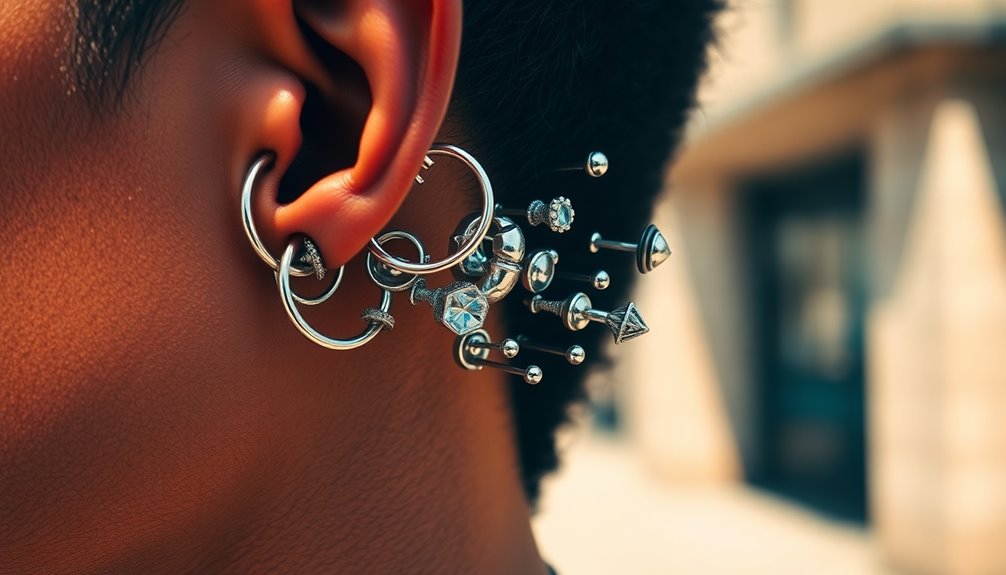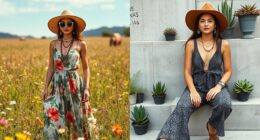Gender-fluid fashion is breaking traditional style norms by blending elements once seen as exclusively masculine or feminine, encouraging you to express your authentic self. Designers and brands now prioritize inclusivity, using versatile styles, innovative fabrics, and unisex accessories that suit all identities. Social media and cultural movements propel these bold styles into mainstream awareness, showing that fashion is evolving to celebrate diversity. Keep exploring to discover how this movement continues to challenge and reshape our ideas of style.
Key Takeaways
- Gender-fluid fashion challenges traditional binary categories, blending elements traditionally associated with male and female styles.
- Designers and brands promote inclusivity through diverse sizing, unisex collections, and campaigns celebrating all gender identities.
- Influenced by social movements and digital platforms, gender-fluid fashion emphasizes authenticity, individual expression, and cultural diversity.
- Iconic staples like blazers, button-down shirts, and accessories are reimagined to be versatile and gender-neutral.
- The future of gender-fluid fashion focuses on sustainability, customization, and technological innovations that enhance accessibility and personalization.
The Evolution of Gender-Fluid Fashion

The evolution of gender-fluid fashion reflects a growing desire to challenge traditional gender norms and embrace individual expression. You begin to notice how clothing no longer fits into rigid categories of male or female. Over time, designers and wearers have pushed boundaries, blending elements once considered exclusive to one gender. This shift is driven by a broader cultural movement toward acceptance and diversity. In the early days, gender-fluid styles appeared as underground or countercultural statements, but now they’re gaining mainstream recognition. You see more brands offering unisex options, and people feel freer to experiment with styles that suit their personality rather than conform to societal expectations. This evolution symbolizes a broader move toward authentic self-expression and breaking down outdated stereotypes. The importance of color accuracy in fashion and design contributes to how these styles are visually represented and appreciated. Additionally, innovative textile techniques like crochet and fabric decorating markers are empowering individuals to personalize their looks and express their unique identities. The ongoing cultural acceptance of diverse fashion choices further fuels this transformative movement, showcasing how diverse fashion has become central to contemporary style evolution. Moreover, advancements in fabric technology enable more sustainable and flexible options, supporting the growth of gender-fluid fashion.
Key Designers and Pioneers Challenging Norms
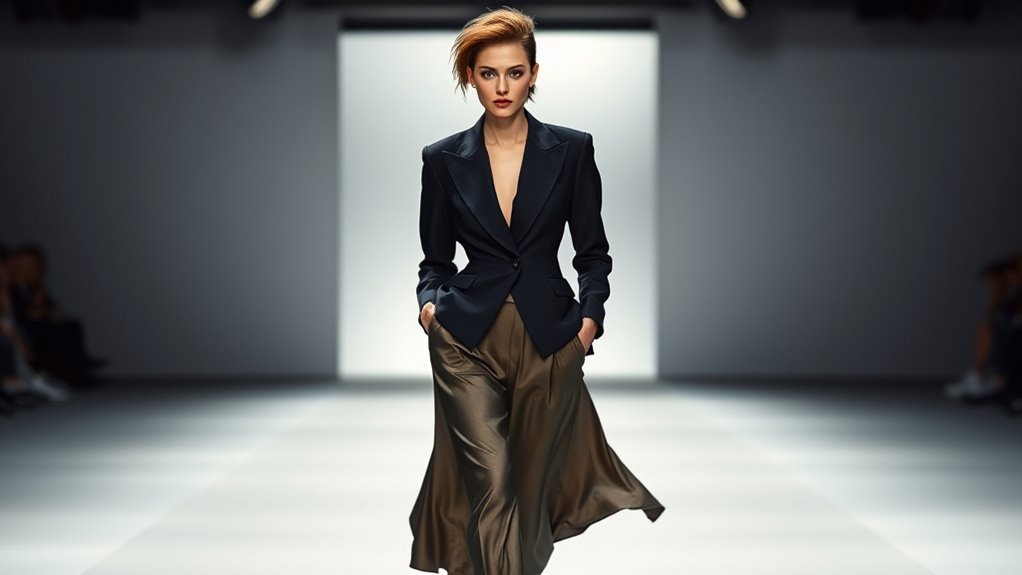
Innovative designers and trailblazing pioneers have played a pivotal role in reshaping fashion norms by actively challenging traditional gender boundaries. They push the limits with bold ideas, unique silhouettes, and unconventional fabrics. These pioneers create collections that blur gender lines, encouraging you to express yourself freely. Their work often sparks conversations about identity and societal expectations. Some key figures include:
Innovative designers challenge gender norms with bold ideas, inspiring authentic self-expression and sparking conversations on identity and societal expectations.
- Raf Simons, known for minimalist yet gender-neutral designs
- Telfar Clemens, promoting inclusivity through accessible, unisex collections
- Grayson Perry, blending art and fashion to challenge gender stereotypes
- Phoebe Philo, emphasizing fluidity and comfort in luxury fashion
- TomboyX, pioneering gender-inclusive underwear and basics
Their influence inspires you to embrace a more fluid, authentic style that defies old norms and celebrates individuality. Additionally, many of these designers incorporate gender-fluid fashion elements into their collections, further breaking down traditional style barriers. Incorporating innovative fabrics and unconventional silhouettes, these designers continue to redefine what fashion can be. Recognizing the importance of fashion as a form of self-expression, they encourage people to explore diverse styles beyond conventional gender labels. Moreover, they often challenge societal expectations by integrating inclusive design principles that prioritize comfort and personal identity.
Iconic Styles and Wardrobe Staples for All Genders
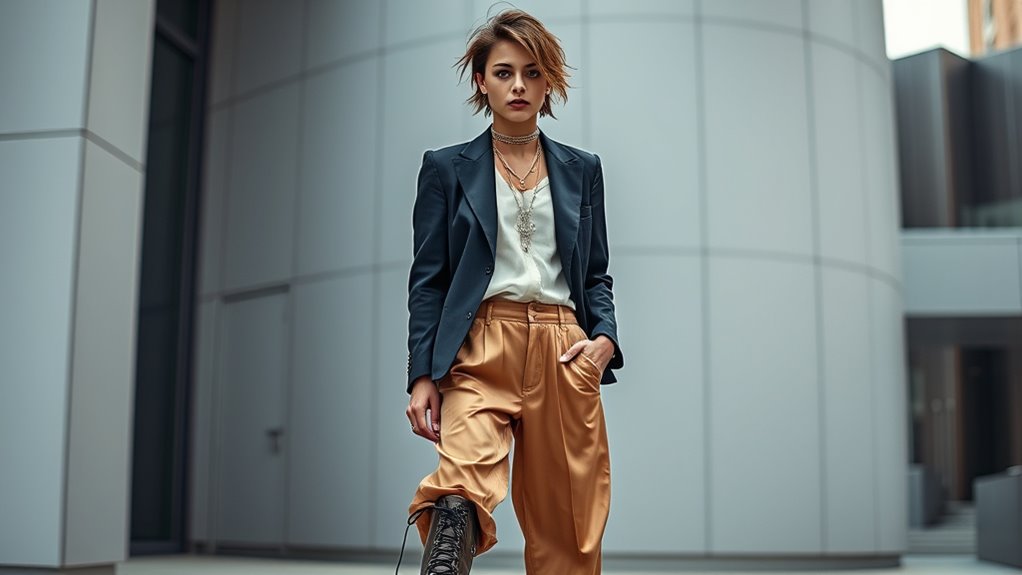
As fashion continues to evolve beyond traditional boundaries, certain styles and wardrobe staples have become essential for expressing fluidity and individuality across all genders. You can’t go wrong with a well-fitting blazer—timeless and versatile, it instantly elevates any look. Classic button-down shirts work just as well for everyone, offering comfort and a sleek silhouette. Sneakers and loafers have become staples that transcend gender, providing both style and practicality. Wide-leg pants and tapered trousers challenge conventional shapes, offering freedom of movement and a modern vibe. Accessories like unisex jewelry, backpacks, and hats let you personalize your style without conforming to stereotypes. Incorporating timeless design elements from different fashion eras can also help create unique, expressive outfits. These staples serve as foundational pieces, empowering you to create looks that reflect your personality and break free from traditional fashion norms.
The Influence of Cultural Movements on Fashion Trends
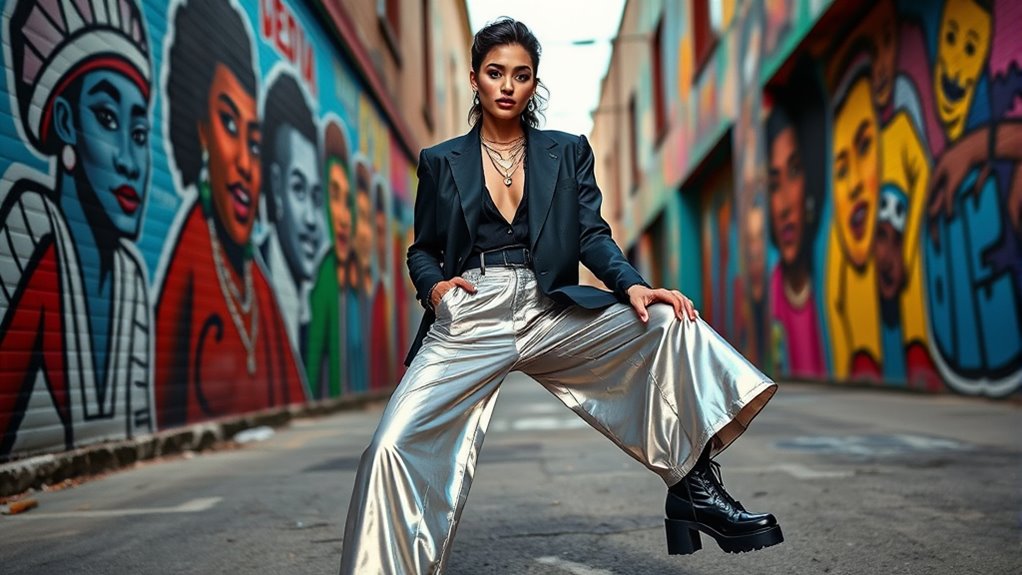
Cultural movements have long shaped the way fashion evolves, reflecting society’s shifting values and identities. You can see this in how protests, artistic expressions, and social philosophies influence trends. For example, the rise of gender-neutral clothing often connects to LGBTQ+ rights movements. Movements like feminism challenge traditional gender roles, encouraging more fluid styles. The punk movement pushed boundaries with rebellious fashion choices, while the hip-hop culture popularized bold, expressive looks. Additionally, indigenous and folk traditions inspire modern designs that celebrate heritage and diversity. These movements not only influence what you wear but also how you perceive style, encouraging you to embrace authenticity and challenge norms. They serve as powerful catalysts for expanding fashion’s boundaries and fostering inclusivity. Developing an understanding of testing methodologies can also help in critically analyzing how fashion trends are promoted and adopted within society, especially as new styles often emerge from market growth and consumer demand. Exploring how cultural evolution impacts fashion can deepen appreciation for the dynamic nature of style and identity, highlighting how cultural movements continue to inspire innovative and inclusive fashion expressions. Additionally, recognizing cultural shifts can provide insight into how societal values are reflected and challenged through fashion choices.
How Brands Are Embracing Inclusivity and Diversity
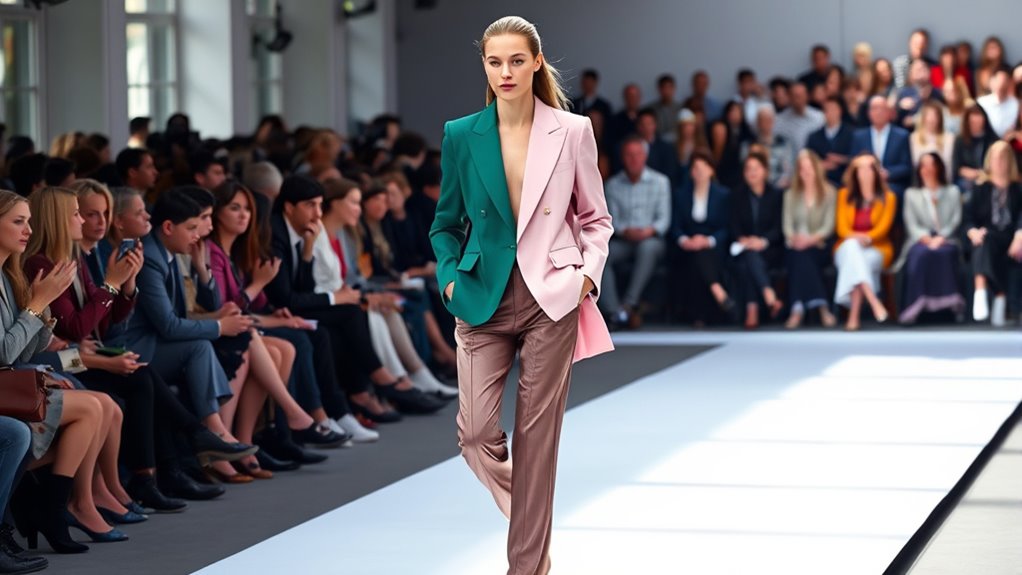
Many brands are actively adopting inclusive sizing options to suit all body types, making fashion more accessible. They’re also launching diverse representation campaigns that highlight different genders and backgrounds. Additionally, gender-neutral collections are gaining popularity, encouraging everyone to express themselves freely. Incorporating electric bike options in their collections is also becoming popular as a sustainable and innovative way to promote mobility and eco-consciousness. Recognizing the importance of inclusive fashion, some brands are experimenting with adaptive clothing lines to cater to people with diverse needs. As awareness of diversity and inclusion grows within the fashion industry, more innovative approaches are emerging to challenge traditional norms and promote acceptance. Moreover, understanding the significance of fashion inclusivity can inspire brands to develop more comprehensive and versatile collections that celebrate individual identities. The integration of electric power into accessories and clothing choices exemplifies how sustainability and innovation are shaping future fashion trends.
Inclusive Sizing Options
Brands are expanding their size ranges to better serve diverse body types, recognizing that fashion should be inclusive for everyone. By offering a wider variety of sizes, they challenge traditional norms and promote body positivity. This shift allows you to find stylish, gender-fluid clothing that truly fits your unique shape. Many brands now include sizes from petite to plus, ensuring no one feels excluded. They’re also designing with comfort and versatility in mind, breaking away from restrictive sizing standards. This movement encourages you to express yourself freely, without feeling limited by outdated size labels. Additionally, embracing size diversity helps foster a more inclusive and welcoming fashion industry that values all identities and bodies. Recognizing that body positivity can inspire personal growth, brands are increasingly reflecting this mindset by promoting diversity and acceptance in their collections. Incorporating inclusive sizing practices not only benefits consumers but also promotes healthier body images across society. Furthermore, emphasizing sustainable and ethical manufacturing aligns with the broader movement toward responsible fashion that values both inclusivity and environmental impact.
Diverse Representation Campaigns
Have you noticed how more fashion campaigns now showcase a diverse range of models, reflecting real-world variety? Brands are actively shifting their messaging to embrace inclusivity by featuring models of different ages, ethnicities, body types, and gender expressions. This approach helps break down stereotypes and promotes a more authentic representation of beauty. You’ll see campaigns that celebrate individuality and challenge traditional standards, making fashion more accessible and welcoming. Companies understand that diversity isn’t just a trend; it’s essential for genuine connection and relevance. By showcasing a broader spectrum of identities, brands empower consumers to see themselves reflected in fashion. This movement toward diverse representation signals a meaningful step toward a more inclusive industry that values every person’s diversity and representation. Incorporating inclusive sizing and diverse aesthetics further enhances the authenticity and reach of these campaigns. Moreover, embracing cultural influences enriches the narrative and broadens the appeal of modern fashion.
Gender-Neutral Collections
As fashion campaigns become more inclusive by featuring a wider range of models, the focus shifts toward creating collections that break traditional gender boundaries. Brands now design gender-neutral collections to promote inclusivity and challenge stereotypes. These collections often feature versatile pieces that anyone can wear, regardless of gender. By doing so, brands foster self-expression and comfort for all individuals.
Key aspects include:
- Using neutral colors and fabrics
- Designing unisex fits and silhouettes
- Eliminating gender-specific labels
- Emphasizing comfort and functionality
- Promoting diversity in marketing campaigns
This approach encourages you to see fashion as a form of personal identity rather than conforming to societal norms. It invites everyone to embrace style without restrictions, making inclusivity a core element of modern fashion.
The Impact of Social Media and Digital Platforms
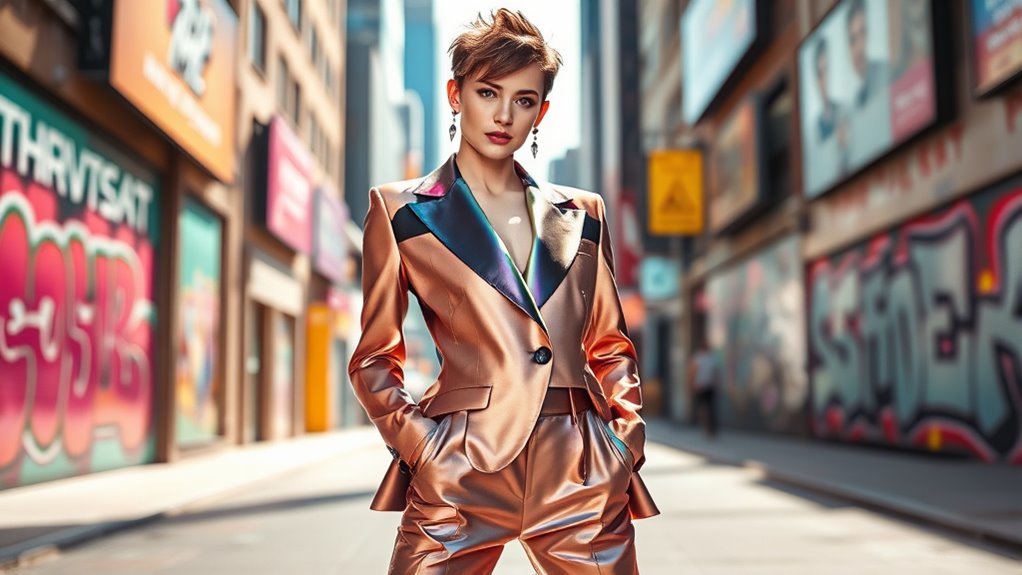
Social media and digital platforms have revolutionized how gender-fluid fashion gains visibility and influence. You can now explore diverse styles, connect with like-minded individuals, and share your fashion choices instantly. Platforms like Instagram, TikTok, and Pinterest showcase real people breaking traditional norms, making gender-fluid fashion more accessible and relatable. Influencers and creators challenge gender stereotypes, inspiring you to experiment with clothing outside conventional categories. Brands also leverage these platforms to promote inclusive collections, reaching wider audiences. As a result, social media accelerates acceptance and normalizes gender-fluid styles in everyday life. You become part of a global movement that values self-expression, diversity, and authenticity. This digital shift empowers you to redefine fashion standards and embrace your identity without restrictions.
Future Directions and Emerging Trends in Gender-Neutral Fashion
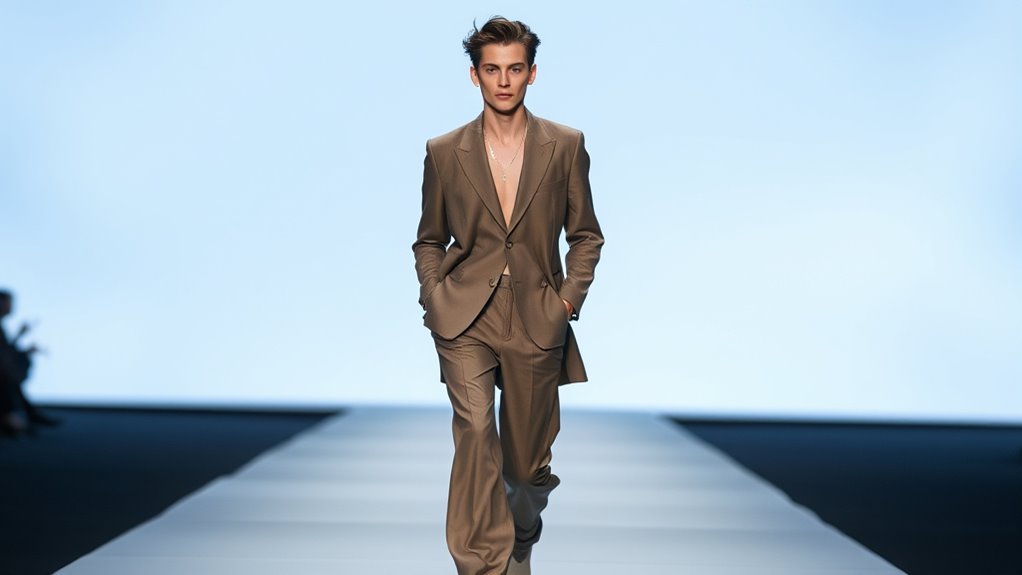
The momentum gained through social media and digital platforms is shaping the future of gender-neutral fashion in exciting ways. You’ll see designers increasingly prioritize inclusivity, blending styles that challenge traditional gender roles. Emerging trends focus on sustainability, with eco-friendly fabrics and ethical practices becoming standard. Customization and personal expression will grow, giving you more options to create unique looks that reflect your identity. Technology like virtual fitting rooms and AI styling tools will make gender-neutral fashion more accessible. Additionally, collaborations between mainstream brands and independent designers will push boundaries further.
- Emphasis on sustainable and eco-friendly materials
- Integration of technology for personalized shopping
- Greater representation of diverse gender identities
- Unisex collections becoming mainstream
- Focus on comfort and practicality
Frequently Asked Questions
How Does Gender-Fluid Fashion Impact Traditional Gender Identity Perceptions?
The current question explores how gender-fluid fashion influences perceptions of traditional gender identities. You might notice that by embracing styles beyond conventional norms, it challenges stereotypes and broadens understanding. When you wear or observe gender-fluid clothing, you help break down rigid gender roles, encouraging others to see identity as more flexible and inclusive. This shift promotes acceptance, making society more open-minded about diverse expressions beyond traditional gender expectations.
Are There Specific Fabrics or Materials Favored in Gender-Neutral Clothing?
When choosing gender-neutral clothing, you’ll notice designers favor versatile fabrics like cotton, linen, and soft knits. These materials are comfortable, easy to layer, and don’t lean toward traditionally masculine or feminine qualities. You might also find stretchy fabrics like jersey or modal that add flexibility. By opting for these fabrics, you create a style that defies conventional gender norms, allowing you to express yourself freely and authentically.
How Do Price Points Affect Accessibility to Gender-Fluid Fashion?
Imagine a vibrant marketplace where everyone can choose any stall they like. Price points are like different stalls—some affordable, others premium. When prices are lower, you find more options accessible, opening doors for everyone to explore styles that break norms. But high prices act like exclusive stalls, limiting who can participate. To truly embrace diversity, brands need to make gender-fluid fashion affordable, ensuring everyone can join the colorful journey.
What Role Do Gender Stereotypes Play in Designing Gender-Neutral Collections?
When you design gender-neutral collections, gender stereotypes influence your choices about colors, cuts, and styles. Stereotypes can limit creativity, making you stick to traditional ideas of masculinity or femininity. To challenge these norms, you actively break away from stereotypes, creating versatile pieces that appeal to everyone. Your goal is to promote inclusivity, encouraging individuals to express themselves freely without conforming to outdated gender expectations.
Can Gender-Fluid Fashion Influence Workplace Dress Codes and Policies?
Imagine walking into a workplace where clothing reflects individuality rather than outdated stereotypes. Gender-fluid fashion can challenge rigid dress codes, encouraging policies that embrace diversity. As you adopt this style, you influence others to see beyond traditional labels, fostering an inclusive environment. Your choices help reshape workplace standards, making them more flexible and accepting. Ultimately, gender-fluid fashion can inspire a more open, respectful atmosphere where everyone feels free to express themselves.
Conclusion
As you explore gender-fluid fashion, you’ll find it’s like a vibrant tapestry woven with endless creativity and breaking free from old norms. Embracing this movement means celebrating authenticity and diversity in your style choices. By staying open-minded and inspired, you can help shape a future where fashion is as fluid and limitless as your imagination. So, step into this exciting world—because, just like a rainbow, gender-neutral fashion adds color and life to every wardrobe.



